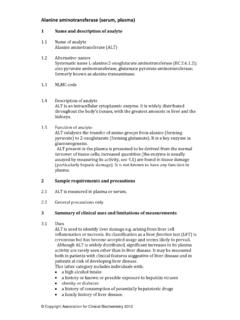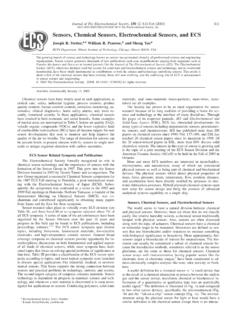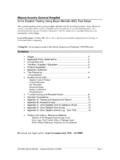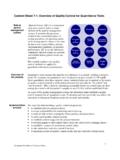Transcription of Method 352.1: Nitrogen, Nitrate (Colorimetric, Brucine) by ...
1 1971 Method : Nitrogen, Nitrate (Colorimetric, Brucine) by Spectrophotometer Method #: for NPDES and SDWA (Issued 1971)TITLE:Nitrogen, Nitrate (Colorimetric, Brucine) ANALYTE:CAS # N Nitrogen 7727-37-9NO3 NitrateINSTRUMENTATION:Spectrophotometer STORET and Method is applicable to the analysis of drinking, surface and salinewaters, domestic and industrial wastes. Modification can be made to removeor correct for turbidity, color, salinity, or dissolved organic compounds in applicable range of concentrations is to 2 mg NO3- of Method is based upon the reaction of the Nitrate ion with brucine sulfateina13NH2SO4solution at a temperature of 100 C. The color of the resultingcomplex is measured at 410 nm. Temperature control of the color reaction isextremely Handling and should be made as soon as possible. If analysis can be made within24 hours, the sample should be preserved by refrigeration at 4 C.
2 Whensamples must be stored for more than 24 hours, they should be preserved withsulfuric acid (2 mL conc. H2SO4per liter) and organic matter will cause an off color in 13 N H2SO4and must becompensated for by additions of all reagents except the brucine-sulfanilic acidreagent. This also applies to natural color present not due to effect of salinity is eliminated by addition of sodium chloride to theblanks, standards and strong oxidizing or reducing agents interfere. The presence of oxidizingagents may be determined with a total residual chlorine test chlorine interference is eliminated by the addition of sodium and ferric iron and quadrivalent manganese give slight positiveinterferences, but in concentrations less than 1 mg/L these are heating of the samples and standards during the reaction time willresult in erratic values. The necessity for absolute controlof temperatureduring the critical color development period cannot be too or filter photometer suitable for measuring absorbance at410 number of 40-50 mL glass sample tubes for reagent blanks, standardsand coated wire racks to hold sample bath suitable for use at 100 C.
3 This bath should contain a stirringmechanism so that all tubes are at the same temperature and should be ofsufficient capacity to accept the required number of tubes without significantdrop in temperature when the tubes are bath suitable for use at 10-15 water free of nitrite and Nitrate is to be used in preparation of allreagents and chloride solution (30%): Dissolve 300 g NaCl in distilled water anddilute to 1 acid solution: Carefully add 500 mL conc. H2SO4to 125 ml distilledwater. Cool and keep tightly stoppered to prevent absorption of acid reagent: Dissolve 1 g brucine sulfate[(C23H26N2O4)2H2SO47H2O] and g sulfanilic acid (NH2C6H4SO3HH2O)in 70 mL hot distilled water. Add 3 mL conc. HCl, cool, mix and dilute to 100mL with distilled water. Store in a dark bottle at 5 C. This solution is stablefor several months; the pink color that develops slowly does not effect itsusefulness. Mark bottle with warning: CAUTION: Brucine Sulfate is toxic;take care to avoid Nitrate stock solution: mL = mg NO3-N.
4 Dissolve ganhydrous potassium Nitrate (KNO3) in distilled water and dilute to 1 liter in avolumetric flask. Preserve with 2 mL chloroform per liter. This solution isstable for at least 6 Nitrate standard solution: mL = mg NO3-N. Dilute mLof the stock solution ( ) to 1 liter in a volumetric flask. This standard solutionshould be prepared fresh acid (1 + 3): Dilute 1 volume glacial acetic acid (CH3 COOH) with 3volumes of distilled hydroxide (lN): Dissolve 40 g of NaOH in distilled water. Cool anddilute to 1 the pH of the samples to approximately 7 with acetic acid ( ) orsodium hydroxide ( ). If necessary, filter to remove up the required number of sample tubes in the rack to handle reagentblank, standards and samples. Space tubes evenly throughout the rack to allowfor even flow of bath water between the tubes. This should assist in achievinguniform heating of all it is necessary to correct for color or dissolved organic matter which willcause color on heating, a set of duplicate samples must be run to which allreagents except the brucine-sulfanilic acid have been mL of standards and samples or an aliquot of the samples dilutedto mL - into the sample the samples are saline, add 2 mL of the 30% sodium chloride solution ( )to the reagent blank, standards and samples.
5 For fresh water samples, sodiumchloride solution may be omitted. Mix contents of tubes by swirling and placerack in cold water bath (0 - 10 C). mL of sulfuric acid solution ( ) into each tube and mix byswirling. Allow tubes to come to thermal equilibrium in the cold bath. Be surethat temperatures have equilibrated in all tubes before mL brucine-sulfanilic acid reagent ( ) to each tube (except theinterference control tubes, ) and carefully mix by swirling, then place therack of tubes in the 100 C water bath for exactly 25 : Immersion of the tube rack into the bath should not decrease thetemperature of the bath more than 1 to 2 C. In order to keep this temperaturedecrease to an absolute minimum, flow of bath water between the tubesshould not be restricted by crowding too many tubes into the rack. If colordevelopment in the standards reveals discrepancies in the procedure, theoperator should repeat the procedure after reviewing the temperature rack of tubes from the hot water bath and immerse in the cold waterbath and allow to reach thermal equilibrium (20-25 C).
6 Absorbance against the reagent blank at 410 nm a standard curve by plotting the absorbance of standards run by theabove procedure against mg NO3-N/L. (The color reaction does not alwaysfollow Beer s law). the absorbance of the sample without the brucine-sulfanilic reagentfrom the absorbance of the sample containing brucine-sulfanilic acid anddetermine mg NO3-N/L. Multiply by an appropriate dilution factor if less than10 mL of sample is and analysts in fifteen laboratories analyzed natural water samplescontaining exact increments of inorganic Nitrate , with the following results:Increment asNitrogen, Nitratemg N/literPrecision asStandard Deviationmg N/literAccuracy asBias,%Bias,mg + + + + + + (FWPCA Method Study 2, Nutrient Analyses). Methods for the Examination of Water and Wastewater, 14th Edition, p 427, Method 419D (1975). Book of ASTM Standards, Part 31, "Water", Standard D 992-71, p 363 ( 1976). , D., and Medsken, L.
7 , "A Brucine Method for the Determination of Nitrate inOcean, Estuarine, and Fresh Waters", Anal Chem., 36, p 610, (1964).















